Lateral Read: An Interview with Lizzy Marshall
Jehra Patrick and Lizzy Marshall discuss 'Agon,' her recent exhibition at David Petersen Gallery, the subtleties of painting and language, and the lineage of mastery.
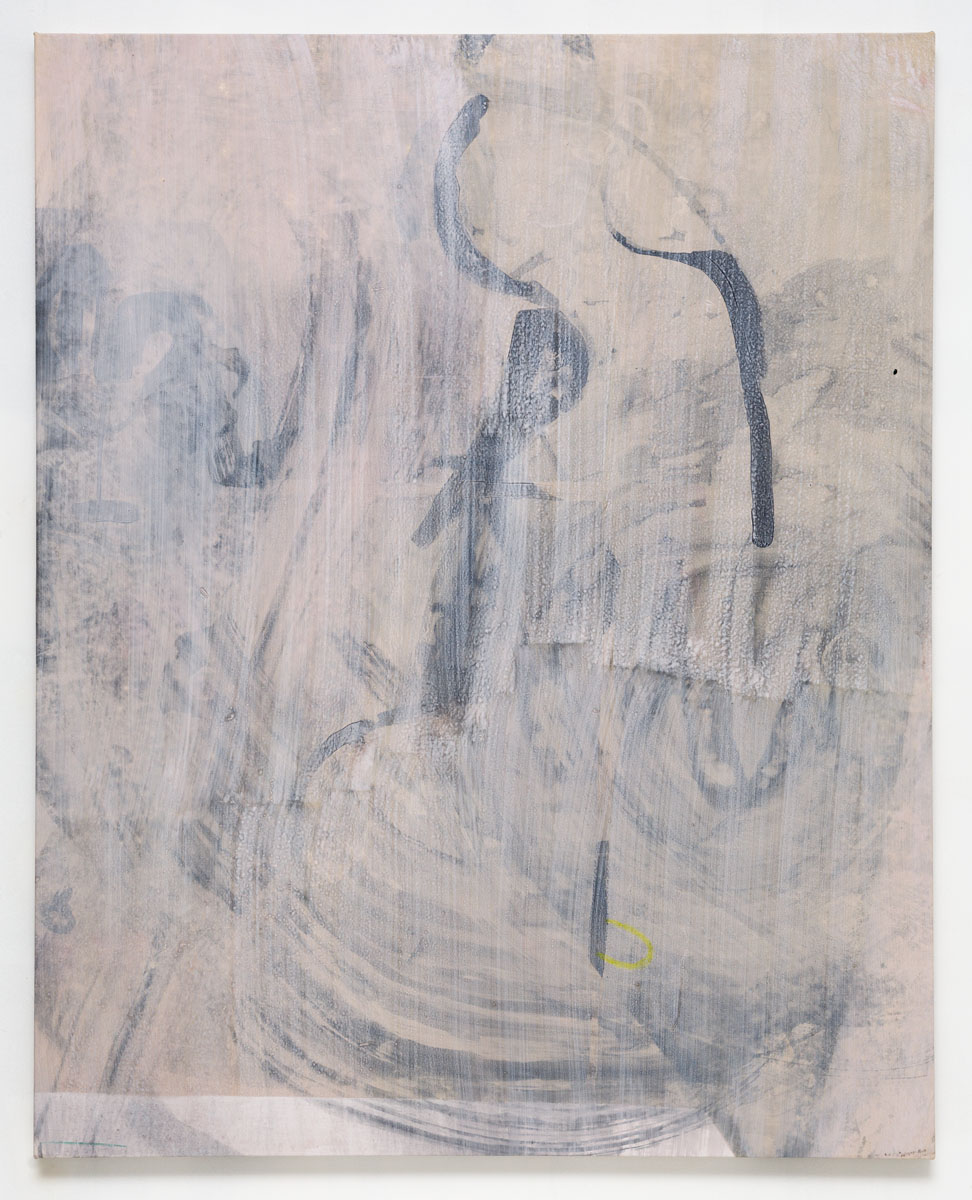
Jehra Patrick
What’s unexpected for me is that I’ve not actually been able to spend time with your work, or get acquainted, online. There’s not a trace of you! By contrast to the way that we acquaint ourselves with other artists now, where there’s so much available online that you can have a preconceived idea of what artist’s work is about before seeing it in person — that can be challenging too, because work often is meant to be experienced in person.
Lizzy Marshall
That’s why we’re making it.
Jehra Patrick
That’s very true. Let’s walk through the room together and you can share a bit about your practice in general. Or, if you want to, just tell me what we’re looking at — that would also be welcome.
Lizzy Marshall
I kind of thought of the exhibition as being read around the room clockwise. The lateral read, which is how we always install work – or how we install paintings, at least. If I could put it in a sentence: All of the paintings are working on reading and looking, being in equilibrium.
Jehra Patrick
That’s important to a lateral read as well, as you prefaced.
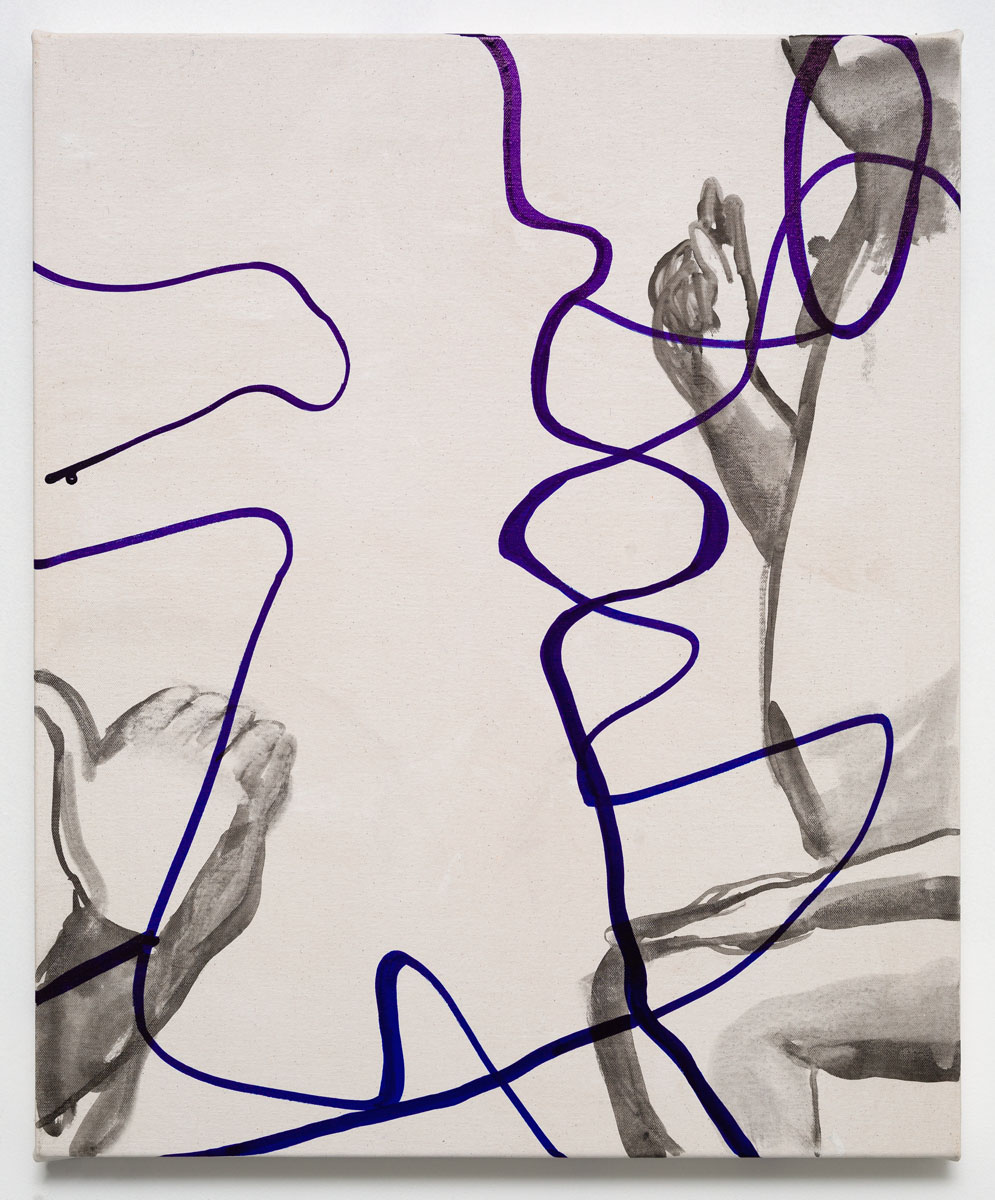
Commodious, 2015, Sumi ink and Krink on canvas
Lizzy Marshall
Yes, exactly, so there’s this kind of weaving in of images and text or lines that look, kind of, calligraphic – in this case, this painting takes it a bit further. Another thing that I do is to take – the figures here are taken from other artists, other paintings, mostly from antiquity — renaissance and classical painting. I’m interested in those images mostly because they were painted – especially in the case of religious painting in churches – for people who were illiterate; the figure was a kind of allegory, [visual storytelling for] mythical or Biblical stories. The hands are particularly interesting. Here are Mary’s hands, for example: the point for me is not to relay something about the Bible, obviously, but something about the body being a sign.
Jehra Patrick
Right. The subtlety of gesture and maybe early introductions to body language — not in the way that body language exists between two humans in person, but language that the body signifies when used allegorically. Western allegorical hand gestures feel more curious — why is that? Is it that they’re more rigid?
Lizzy Marshall
This sign that Christ has in many paintings. It’s kind of like here, so this is from Giotto. This is Christ and this is Mary’s hand doing this. (pointing to Commodious)
Jehra Patrick
Kind of like a thumbs up.
Lizzy Marshall
Strange.
Jehra Patrick
Very strange.
Lizzy Marshall
I don’t know, maybe it’s a bit irreverent
So, this weaving of image and language brings in all kinds of other things, like rebus or a cypher, just letters piled on top of one another. Sometimes I think my work is really just about painting and ways to keep the eye moving.
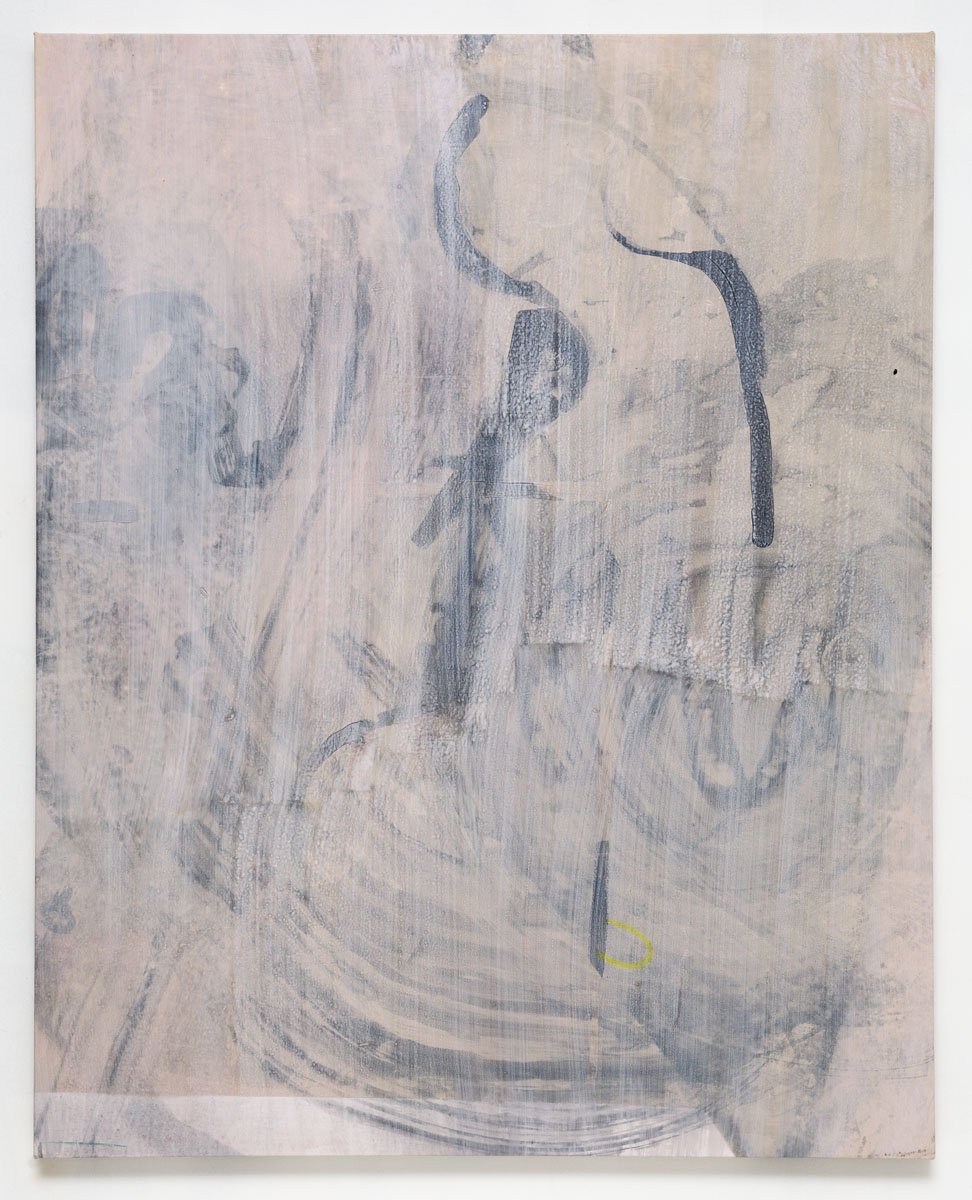
Lo, 2015, acrylic, Sumi ink, beeswax crayon and powdered marble on canvas
The way we’re trying to understand information is reading — is lateral — and looking is something else. I want the reading to kind of spiral into the painting somehow. This painting has its own really large gesture – LO’ meaning low and behold, “look.” It’s subtle.
Jehra Patrick
It is, yeah. But it does do that radial activity and the bouncing motion that you’re interested in, and that all-over reading. What does reading feel like when you’re moving through the painting, in terms of depth?
Lizzy Marshall
You mean for me?
Jehra Patrick
For you or for your viewer. If we think about reading as lateral, and we think about expanding that to an all-over read, or a bouncing or circulating way of looking, what constitutes reading in that sort of inward, or in that ‘Z dimension,’ I guess?
Lizzy Marshall
I think it’s different for each painting, which is the fun of it, too. There’s something in this yellow mark: it could be, potentially, protruding out, but it’s in the foreground, just this little mark that the eye can catch on and that subtly pushes this back and sets up these kind of different spatial [relationships].
Jehra Patrick
Yeah, this one is particularly rich. What are some of the materials you’re employing here?
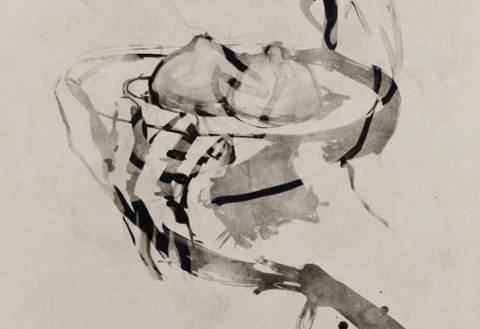
St. Agnes, 2014, Sumi ink and acrylic on canvas
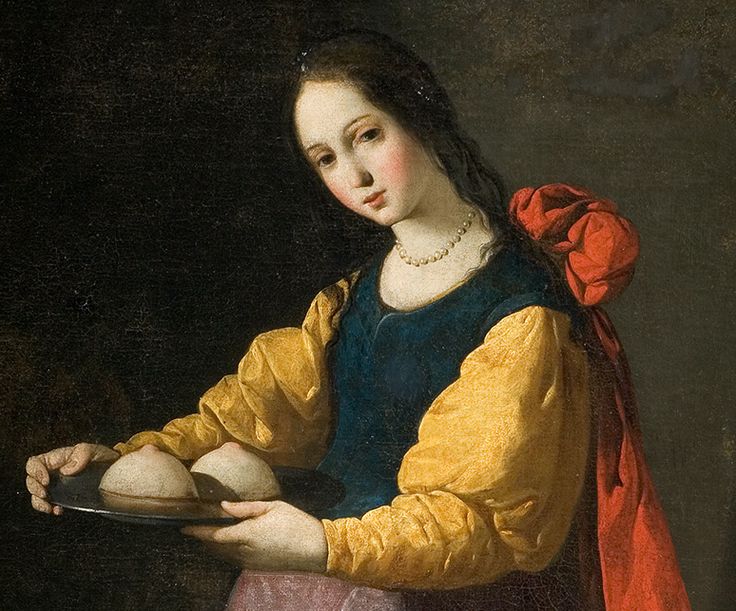
Saint Agatha Bearing Her Breasts on a Plate, 1630-33 Musée Fabre
Lizzy Marshall
The first layer is Sumi ink. I use ink and acrylic medium to make a kind of double image that [was produced from] a fragment of a painting of St. Agnes, which has two cut-off breasts on a plate. I saw this in a museum and it was just….not knowing what that meant – bizarre and so violent. It strangely connects my mind to this transformation of gender that’s happening now, too. And so, then I layered that with this other hand wiping a plate clean. It’s woven together.
Jehra Patrick
Domestic act on top of degendering.
Lizzy Marshall
The technique that I’m using is ink initially, and then going over it with acrylic and washing the whole thing out, so the acrylic preserves parts of the ink drawing. You end up with something like batik. It’s being erased, but there’s a stain [left behind].
Jehra Patrick
And that ‘stain’ quality of the Sumi ink is important, maybe, to the way your work is relating to older forms of communication like calligraphy? Or are there attributes of the way that it moves that are a new language that you’re interested in?
Lizzy Marshall
It’s a fluid and it gave me a lot of freedom. I can have this really graphic image, but it’s still organic looking. And there’s also the ability to erase it, which is really exciting because a lot of painting for me is editing or obscuring.
Jehra Patrick
Those are interesting verbs to select as well when you’re talking about image as language; part of the process is to act as the editor, to erase or redact.
Lizzy Marshall
There’s definitely a linguistical relationship to my work that I’m still sort of working on and discovering and reading about, too. [Recently] Roland Barthes is really interesting to me. My studio time starts with reading, often.
Jehra Patrick
Art theory, or…?
Lizzy Marshall
No, not art theory. Mostly poetry and some art history; art, I guess, is philosophy. Poetry is also very helpful and encouraging.
Jehra Patrick
I can see how many of these read as poems: the way you’re structuring the imagery and the way that poems and poetry are also laid out sometimes as a visual mechanism to move through – much as you’re doing. You’re moving your reader or your viewer through your work. What poets interest you most?
Lizzy Marshall
Anne Carson is one, and then Lisa Robertson is another.
Anne Carson is a historian. She’s an ancient Greek historian. She teaches ancient Greek in different universities, so she’s also translated a lot of Sappho. She takes that historical knowledge and puts it into what seem to me to be very personal kinds of writing.
My cousin found this amazing book of Anne Carson’s called Nox, it’s an accordion style book that opens up, and it’s about the death of a brother. She’s layering that with fragments about Catullus — each page has a scan of a typed-out and ripped out piece of writing, or a photograph, or a small drawing. It’s a really nice book.
Jehra Patrick
It sounds like a treasure. What’s your relationship with artists’ books? Is that something you’ve tried in your work, knowing that you’re interested in sort of the way we read and move through information or images?
Lizzy Marshall
I’ve been thinking about that. I haven’t actually made one, and I think I really need to, to take this further. Another thing that’s interesting is that there’s always a diptych in the book, too, and that’s another form that I want to keep pushing.
Jehra Patrick
You have a relationship with paper already, in the way that you’re sort of feeding your work through poetry – and you’re reading and drawing, of course. This strikes me as a way to dimensionalize, or move through paper in a different way. Not even bound – but abstract and structural artists’ books, as well, might be an interesting venue for you to pursue.
Lizzy Marshall
Yeah, that’s true. Good point.

Codex, 2015, graphite on paper; graphite, Sumi ink and acrylic on canvas
Jehra Patrick
I wonder is there any particular imagery or are there specific allegories you’re calling attention to in the work? I know you mentioned a couple from particular paintings, but that might be an important reference to know about your work — even for some of the more abstract forms. Would you like to tease any of those out for me?
Lizzy Marshall
You mean what the original context is, or…?
Jehra Patrick
Or maybe what drew you to those images, or their importance for inclusion. And maybe it’s just purely formal, too…
Lizzy Marshall
It’s pretty formal. The form of the figure can hold meaning, without determining a narrative.
We have this system of characters that are interchangeable, and the meaning for one unit is never fixed. I think that’s what I’m working with on the body, and so there is an arbitrariness to the figures included.
Jehra Patrick
You’re using [the body] as expanded characters – they’re really just advanced glyphs.
Lizzy Marshall
Right. There are also some really intimate and emotional signs that are in the painting which I’m choosing, too.
Jehra Patrick
These all feel like very intimate works.
Lizzy Marshall
Intimate and tender. It’s a sort of personal drive.

Knot Eye, diptych, 2015, graphite, Sumi ink, powdered marble and acrylic on canvas
Jehra Patrick
As I look at what’s included [in the exhibition] there’s a lot of very gestural images – like you mentioned, graphic or character shapes and gestural figure shapes. This [diptych] feels much more like an advanced practice, like there’s more time spent here; maybe it’s a new direction for you. Do you want share anything about the treatments for these pieces?
Lizzy Marshall
This is one body. There’s one arm and then and this is the other arm. This is a breast here, so….the figure of those kind of spills out of the frame and into the other.
The writing in this is taken from reading Lisa Robertson and also part of an automatic free-write sort of thing that I put onto the canvas. I haven’t really done that before, so this is – this diptych is the newest one – not totally new, but it’s still fresh for me. I wanted to make it a diptych which was one piece, one kind of body, and then find a way to pull them apart. So, there’s this tension of being one, but then being separate.
Jehra Patrick
Your treatments [to each] definitely distinguish them. Do you typically do activities like writing or free writing exercises outside of the canvas? Is anything like that a regular part of your practice, or was this really the first move in that direction?
Lizzy Marshall
I do some writing, but it’s definitely not very composed. So, you might call it free-writing.
This painting went through [several iterations]: there are three paintings underneath. It was difficult to make two paintings that had to be together…..others have a relationship…..I knew that I could rearrange them, but I needed them to have this kind of fixed form. That is, if I have already decided that they go together, then I have to find a way that they actually can exist next to one another.
Jehra Patrick
If these are characters, and they’re interchangeable, and you can make these sorts of words with them, then maybe they are a bit like pages that are next to each other. They have to be there in order for whatever the narrative is to continue. Does that sound right?
Lizzy Marshall
Yeah. And it is this kind of like fragmentation of the body that’s happening as well. In this case it’s fragmenting into language, like there’s this kind of correspondence between the eye and the ear, and other parts of the body sort of end up in conversation. I imagined that you would be reading this; you’re looking at the body, but it’s, again, a kind of reading and looking. You’re looking at the figure that’s mute, and they’re looking back at you, so there’s this kind of mutual observing.
Jehra Patrick
I see relationships to someone like Joseph Kossuth, except you’re doing it in a much more intimate and tender and personal way, where he’s very clinically telling you: ‘this is a chair; this is what one looks like; this is the word.’ His interest is much more in evidencing, I think, semiotics itself and how we view things. You’re doing that in a very subtle way, and more naturally, following the ways things interact, or maybe not even in the first encounter, but also following how we digest or synthesize those things, in a personal way.
Lizzy Marshall
Of course, there’s Magritte, too, who really plays with naming, captioning, and meaning.
Jehra Patrick
It’s the pipe. It’s the eye.
Lizzy Marshall
Yeah.
Jehra Patrick
It sounds like your work comes from a deeply art historical perspective without having that necessarily be the foreground of your content, as if you carry a lot of other artists and historical moments with you while you produce. Is your background in art history, or did you begin with studio practice first?
Lizzy Marshall
I went to art school. I studied art history as much as was required, but since then it’s more been a personal interest.
Jehra Patrick
When you encounter art historical imagery, are you taking them in by book, or are you seeing work in person? You mentioned that one particular museum, seeing the image of the severed breasts on a plate: that sounds like a really important person-to-work encounter.
Lizzy Marshall
All of the above. This [in the diptych] was taken from a Watteau drawing on the cover of a Jean-Luc Nancy book called Corpus. This (pointing to Attached To) is an Artemisia Gentileschi fragment that keeps the distancing going by pulling that even further out of context. The face in this one, here, is taken from a sculpture I saw in Denmark and then photographed.
Jehra Patrick
It’s really a beautiful one. I can tell that was from more of a time-consuming investigation. And you really didn’t smudge it out, as with some of the others. You preserved quite a bit of it, and maybe eradicated it with the white sort of page in front of it.
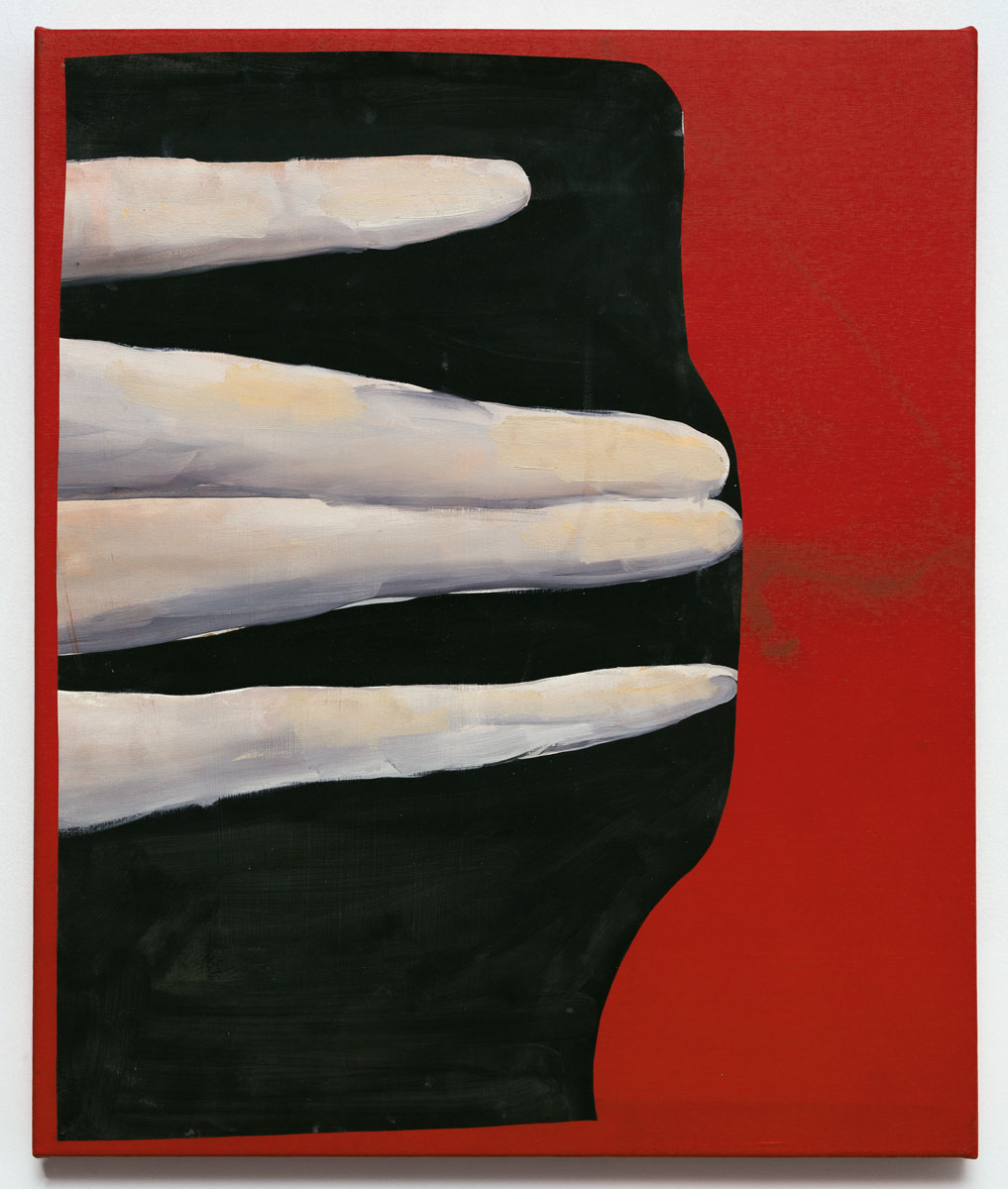
V/Coda, 2015, oil on paper; charcoal acrylic on canvas
This one feels like a stand-alone in the show; if we’re thinking about the literary connotations of the rest of the work, this one feels like punctuation.
Lizzy Marshall
This one too, I think, for me. Especially the bright color.
Jehra Patrick
That one’s maybe like a giant period, and this one is an exclamation.
Lizzy Marshall
Sure, yeah.
Jehra Patrick
Let’s take a closer look at this one. This is a work on paper?
Lizzy Marshall
Yes. It was just a test for something, for what I thought I might put into another painting, and then it hung around the studio for a couple of years. I was always looking for a place for it: should I just repaint it into a painting? No. Then I just put it actually into the painting. Now, this edge is really satisfying for me.
Jehra Patrick
I would agree. It’s emulating an old Byzantine, decorative style – that’s really strong.
Lizzy Marshall
This, putting the drawing into the painting, happened first with this work here. It was something I’d always wanted to do; I don’t know why I didn’t just let myself do it.
Jehra Patrick
We’re taught that things need to be hyperarchival; it’s always ‘fat over lean,’ so why would you do ‘paper over fat.’
Lizzy Marshall
Right, like ‘I don’t do collage,’ or other sorts of stupid things that we make up about ourselves. Or not stupid, but so that it feels like I’ve actually done something that someone told me not to do. Here is was like: what happens if I take it further and stick this drawing onto this canvas permanently, and not as a provisional idea? With the direction of that figure I wanted it to kind of push into this lateral feed on the ground, but to do so in a way that it wouldn’t make up a storyline, that the paintings wouldn’t be perceived as units of a story, but more like a current — a way to push the eye around the room. The arm of this [diptych] figure lands on the fingertips of this [red] painting. It’s fragmentation and dispersion around the room, and this other painting is the fissure in that stream.
I’m interested in the multiplicity of the images, that arbitrariness, and what it has to do with the world we’re living in now. I mean, most people live with an Instagram feed; there is this disjuncture between that continuous imagery.
Jehra Patrick
We’re comfortable seeing non-narrative — but that is, in itself, a larger narrative, right? Because it’s in our surroundings, the images that surround us. So, to jump from one treatment to another [within one work] is a piece of cake.
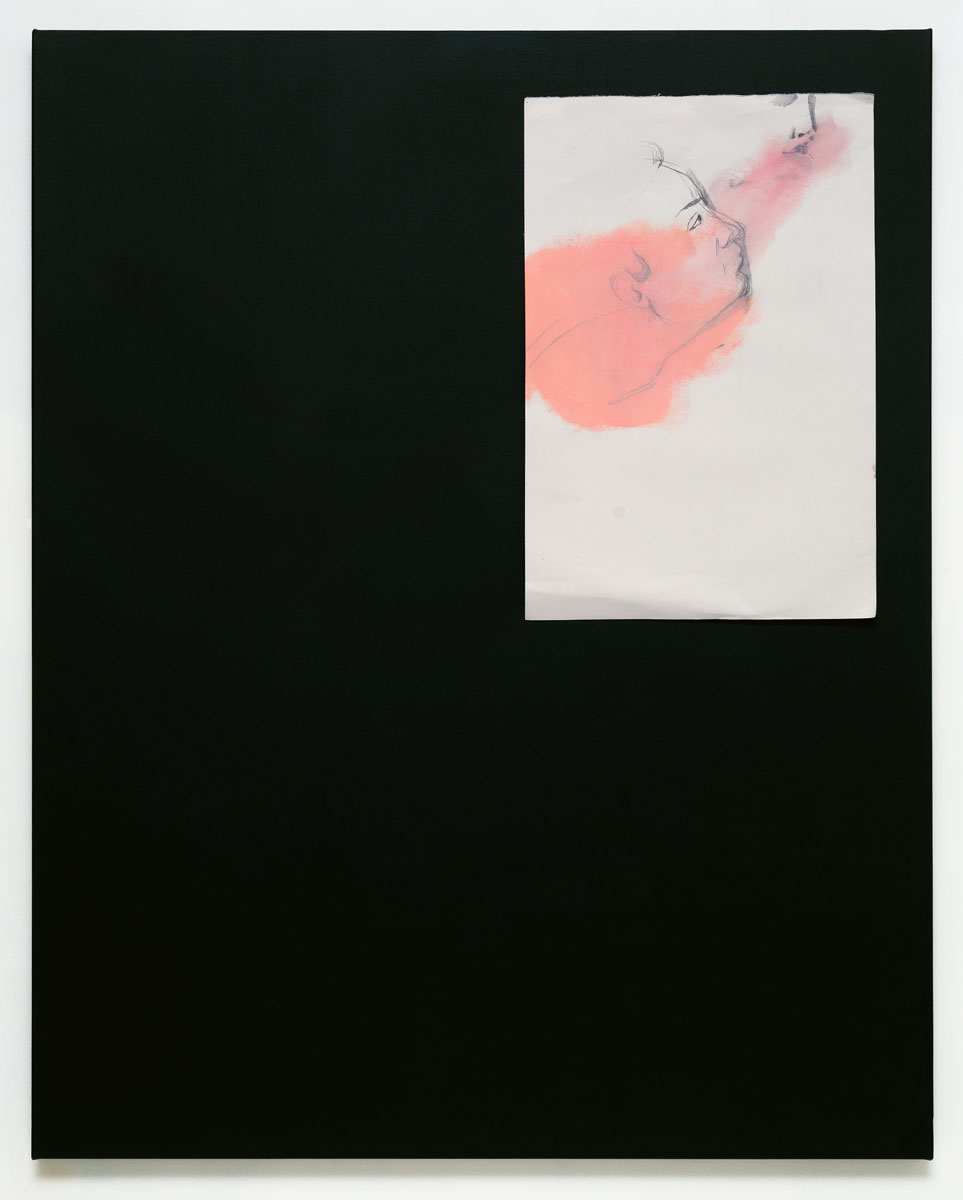
Attached To, 2015, oil and graphite on paper; acrylic on canvas
Lizzy Marshall
We’re not really processing what that is. The piece of paper on top is what I think of as a temporal zone in the painting – it’s completely separate from the ground of the image. Because that’s what I’m experiencing in my life: it’s this cut, this disjuncture, and that’s something we see in Skype, too. There’s a frame, and then there are two, interacting frames.
Jehra Patrick
It’s funny – I was already applying it. I know your work’s not necessarily about technology, but it’s a part of all of our daily lives now. Technology just is not a separate field any longer. These [works] reminded me of the way we’re always looking at windows in windows. Of course, there’s a long relationship between painting and windows and architecture: the idea that painting is a thoroughfare to something else. So, the Skype relationship – that [painting] could be like your safe window and your screen background, right?
Lizzy Marshall
It’s definitely that, but it’s difficult to know how to bring that in. I don’t really enjoy looking at work where I know it’s this kind of one-to-one with the digital or screen life. I kind of want an escape from that, and I want painting to definitely exceed that kind of experience. At the same time it’s really part of our aesthetic, part of the world we’re in, so it’s inevitably present.
Jehra Patrick
I see that. I also know that you’re mentioning the migrating of the rectangle through the pieces, so another means that it’s progressing from left of center to center to right of center of this piece down here.
Lizzy Marshall
Right, yeah. This gesture of the thumb points inwards to the show.
Jehra Patrick
Are you familiar with the work of R. H. Quaytman at all?
Lizzy Marshall
She was my teacher.
Jehra Patrick
Oh, no kidding! I was going to put in parallel your practice of ‘guiding’ throughout a painting. That’s interesting. She often leaves cues in her work that direct you to the next piece and talks about her work also as progressing, as ‘reading.’
Lizzy Marshall
I relate to her – it’s the sequencing of the movement that’s really interesting. She’s found a way to really talk about it as reading.
I think I want my work to bounce around a little more though.
Jehra Patrick
[The show] strikes me as being more about reading independent objects and more brief juxtaposition. Although I think in the install of the show there’s been a successful planning of layout to make that work on a broader scale, that, of course, if we were to see these among other works within your studio, might not be apparent until you get them in a reduced space.
Lizzy Marshall
Yeah, exactly.
Jehra Patrick
Has your practice always operated within painting?
Lizzy Marshall
Yes. Last year I learned fresco painting and I’ve been practicing a little bit, but it’s really fussy, so I think I need to actually train with someone who knows what they’re doing. I spent five days with someone, learning, but I think I need more because it’s something where you need to master – you need to actually be able to master something, which is laying down the lime cement, and you have to learn how to be a plasterer.
Jehra Patrick
Right. It’s on the walls – essentially a ‘home improvement’ practice.
Lizzy Marshall
It’s a really different kind of construction.
Jehra Patrick
I like that you use the word “master”, and especially with regard to painting and history. What are your thoughts around the occupation of being a master at this point in time. What does a master look like in 2015?
Lizzy Marshall
I think it’s just a word. You know, we have a master’s degree. We have an MFA degree that puts all of us in incredible debt. I don’t know how we can go back to that word in a sense after this – all these de-skilling ideas. I think we talk more about craft and technique.
Jehra Patrick
And it’s sort of what the word is historically linked to, right? As a craft and technique.
Lizzy Marshall
It’s also a position of authority, right?
Jehra Patrick
True.
Lizzy Marshall
If R.H. Quaytman was master and I was a student, but I don’t know. It’s a tricky one. Also it was a patriarchal kind of lineage as well.
Jehra Patrick
Yes. I think you made a great comment about the proliferation of masters programs, and so now master isn’t just a one-to-one or even one to even two or three. It’s like 1-to-50, and then the next year it’s 1-to-50, and that’s happening in 80 programs across the U.S.
Lizzy Marshall
Right, so pretty soon we’ll have 500 masters a year.
(both laugh)
Jehra Patrick
Lots of masters! Yeah, it’s really interesting notion. I’ve talked about the complications of the academic system with many colleagues, but I don’t think we’ve quite nailed the ‘master’ joke yet, so I’m really glad that you and I could do that.
Lizzy Marshall
It’s complex. I’m still not really sure how to answer your question about mastery.
I’m really fascinated by the technique that was developed over hundreds of years of painting. It’s like – it seems like brilliance and genius and all this stuff – but it’s more about commitment to [the medium] – and actually to think about the time that these people had in their lives to really – it’s something that seems sort of radical now.
Jehra Patrick
It was all-in approach, right? Like I think artists working contemporarily don’t really have that time allocation for all-in approach to their work. When we talk about the ‘provisional painting’ movement, a lot of the understanding of why paintings are being produced in that manner was that we’re all short for time. If you’re living and working in a certain areas with super high rent, then you’re working somewhere else to supplement that, and the time that you have left to your work is so minimal that what happens in the studio in that short amount of time in contrast to the “lifer” – the master in the 1700s who was able to just do that every day until they died… at 40, or whatever.
Lizzy Marshall
I think it seems also that mastery has something to do with developing a style, and once you develop a style as a master you can teach other people to carry that on, and that also could help you execute your paintings. I never thought about style in my work so much.
Jehra Patrick
That passing on style thing is an interesting one, and I think about the professor and student relationships locally, and you’ll see a young up and coming painter and everyone shines upon their work, and then you see it actually looks a lot like this person they’ve studied under, and that’s interesting, and I wonder how that relationship feels.
The idea of permission complicates this further. So does guidance, where a professor extends their practice and problem solving ,“ Well, how are you going deal with this corner up here?” and how does that actually impact the [artists] work as they carry out the wishes and interests of that instructor?
Like here I could note small sub-schools of certain mid-career and established artists, that are being executed by the next generation. But “master” – I’m not sure.
Lizzy Marshall
I don’t know how that word reflects a person in this day.
Related exhibition information:
‘Agon,’ an exhibition of paintings by Lizzy Marshall, is on view at David Petersen Gallery in Minneapolis from September 11 to October 17, 2015.
All images courtesy of David Peterson Gallery, 2015